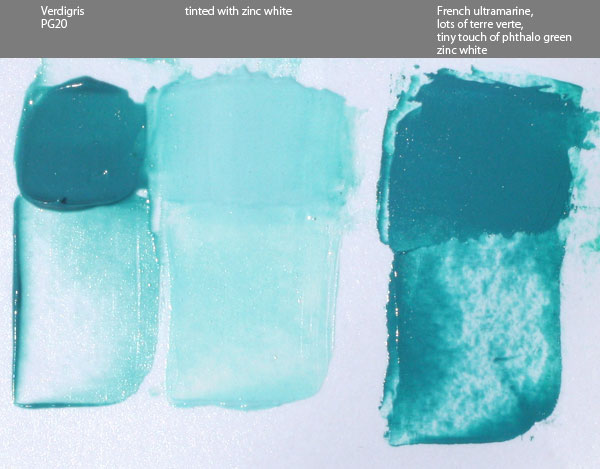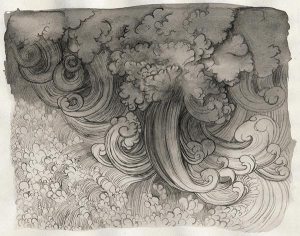
After my first verdigris post I made some more pigment and now I finally got around to making some proper oil paint with that, seen on the left of the image above. This was made with poppyseed oil and it was very easy to mull, requiring almost no effort. The finished paint is a really nice turquoise that’s extremely transparent and has extremely low tinting strength. I used a 1:1 mix with zinc white to tint it and it was still very strongly affected even by zinc white, so glazing seems to be the best use for this pigment in oil.
As I mentioned before, almost no one at all presently sells verdigris as either a dry pigment or as a paint of any kind, even though for a couple thousand years it was among the most vivid greens available. A big reason for that is the mix I made on the right side of the image above. Verdigris is moderately toxic and well known to have problems with lightfastness, but the mix I made using only lightfast, non-toxic, and inexpensive paints is nearly a perfect match. I used a lot of terre verte (hoping it’d lend transparency and low tinting strength), french ultramarine, a very small touch of phthalo green to increase the chroma, and zinc white (again hoping for transparency).
The mix isn’t as transparent and has far higher tinting strength, even though I used so much terre verte. Plus, the mix was only intended to match verdigris. Exceeding its chroma with the same hue is very easy with modern pigments, and the high transparency could probably be matched by adding some painting medium to the mix.
In conclusion, my curiosity of what this historical pigment was like has been satisfied and I can now say that it really is an obsolete pigment. It was fun and interesting to make, but there is really nothing that it would offer today that isn’t done better by modern pigments.

Here’s a photo of the second batch of pigment that I made in the copper dish, again using white vinegar. I tried using a different kind of vinegar, I think rice, in a separate dish but it only had a minimal development of verdigris and didn’t look any different.
UPDATE

Left: Verdigris mixed with cadmium yellow pale (Winsor & Newton, about 15 year old tube)
Right: the same cadmium yellow mixed with blues and greens to approximately match the mixture on the left, as a control sample
Photographed after 48 hours.
As you can see, the verdigris appears to have darkened significantly. I believe it’s in reaction to the sulphur in the cadmium yellow. From what I’ve read verdigris can also darken just from sulphur in the air.

For some reason the original swatch of verdigris, on the left, has also changed color in comparison to the control swatch on the right. In this case it’s more of a hue shift than a darkening though. This swatch was made a little less than 4 days ago.
So my experiment with making verdigris probably didn’t make the purest or highest quality pigment possible, and there’s obviously things that I don’t know about chemistry, but what I’ve seen has reinforced my opinion that this historical pigment is obsolete when I consider that I have never seen paint change like this before.

and jadeite genuine
from Daniel Smith, as well as Verona green earth from Rublev. So just two earthy greens and an earthy yellow.
for the majority of the details. Both that and the sceptre gold are natural and synthetic blends.
















